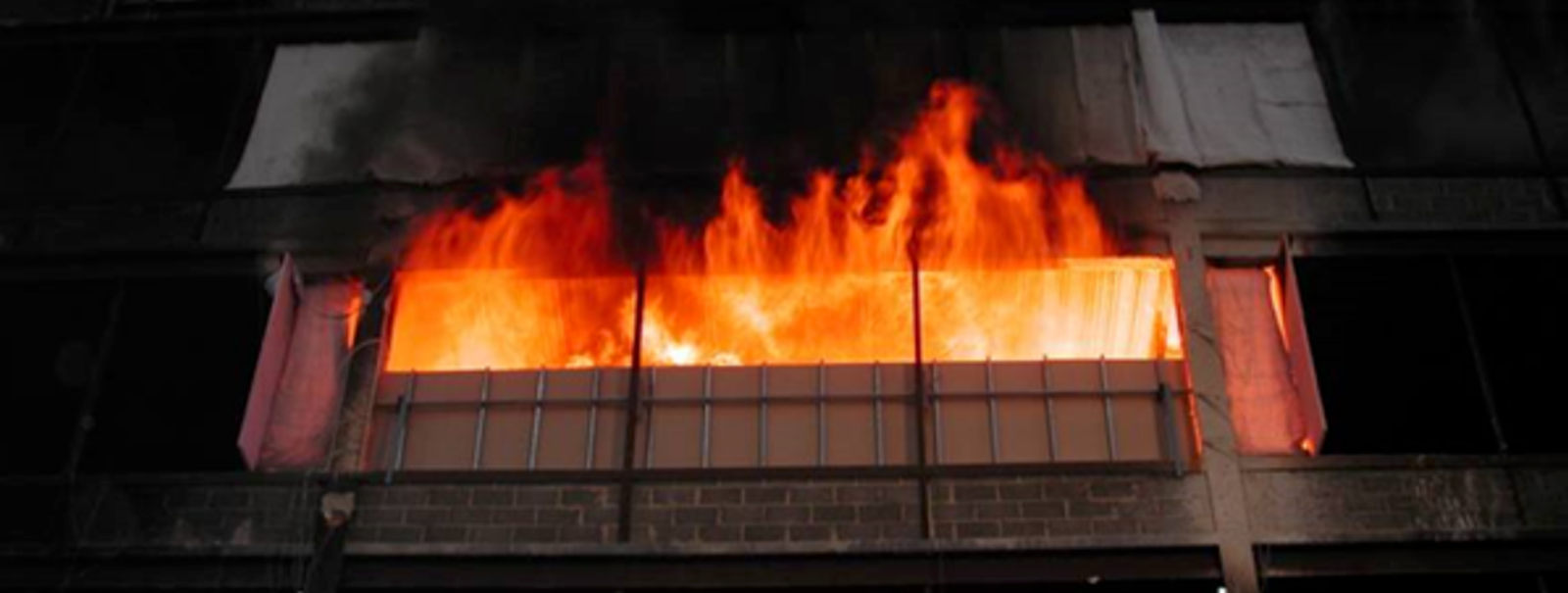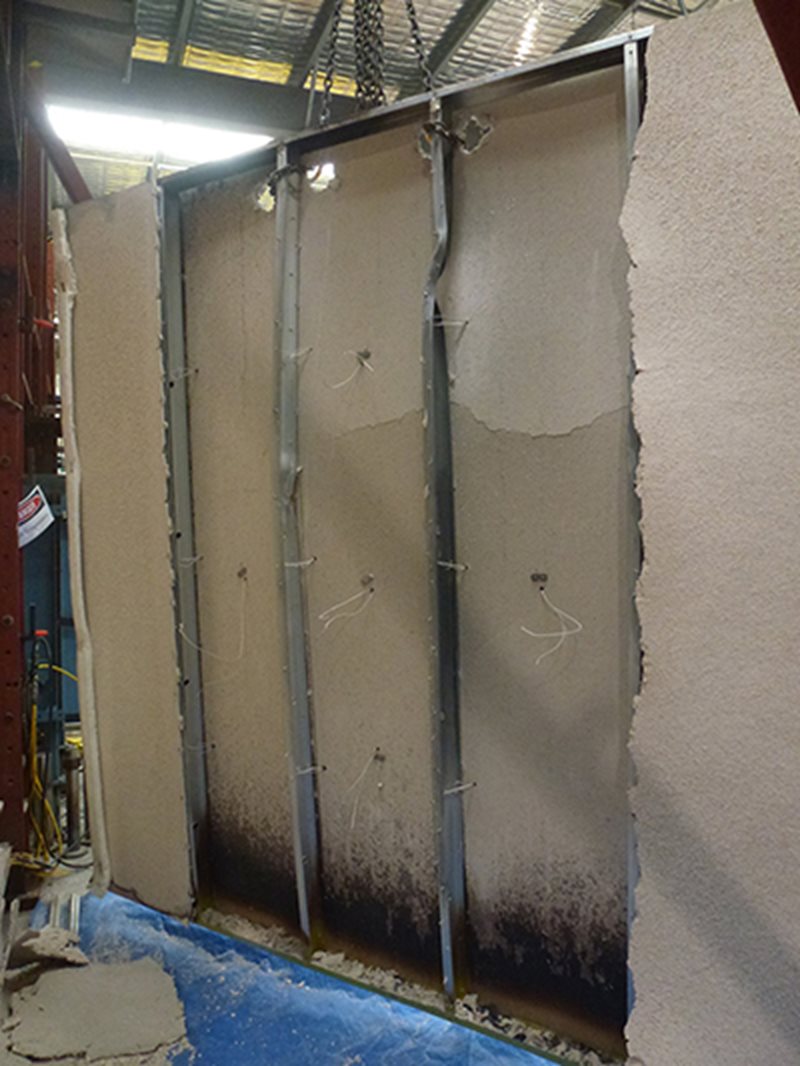

All construction materials weaken with temperature and suffer varying forms and degrees of both visible and hidden damage.
The assessment of fire damage and the subsequent reinstatement of the structure should be actioned under a well-defined assessment process using established assessment methods and informed by an understanding of both how the construction material properties are affected by temperature and how the structure itself distorts due to the physical changes imposed by the fire loading.
.png?variant=FullWidth)
In respect to steel structures, the consequences of fire loading can include:
a reduction in the strength of the material, leading to potential deformation and failure under imposed loading
embrittlement of the material due to rapid cooling associated with fire-fighting efforts
expansion of the steel, leading to deformation and increased stresses, depending on the degree of restraint imposed by the structural system
weakening or failure of connection elements such as bolts and welds
impact damage from dislodged or failed construction materials
destruction of protective coatings and/or fire protection coatings
progressive collapse of the structure due to localised failure of key structural elements.
Having said this, compared to other building materials that may require complete replacement or even demolition of the building, steel is an extremely workable material as regards identification of damage and ability to repair and reinstate in a cost and time-effective fashion.
Like all materials, steel weakens with an increase in temperature. Strength loss for steel is generally accepted to begin at about 300ºC and increases rapidly after 400ºC. By 550ºC steel retains about 60% of its room temperature yield strength. However, at temperatures below about 600ºC, if the steel is cooled it returns to its original strength, stiffness and ductility.
At temperatures above approximately 600ºC, structural steel may suffer some deterioration in residual properties after cooling. For normal grade steel (yield strength 250MPa to 275 MPa), however, in no situation, whatever the fire temperature, will the room temperature yield stress or tensile strength fall further than 10% below their original values. Thus, where it can be assumed that the steel members will be utilised to less than 90% of their maximum load bearing capacity, replacement of the member should not be considered necessary, provided other performance characteristics, such as straightness, have not been compromised.
Higher strength steels (yield strength around 350 MPa) obtain their increased strength as a result of alloying elements such as vanadium and niobium. At higher temperatures, these elements tend to precipitate out of the matrix, creating a course distribution. Higher strength steels therefore have a proportionally greater reduction in yield stress and tensile strength than the normal grade steels.
Steel members and assemblies distort under fire loading due to a number of factors:
The reduction in the steel yield stress due to elevated temperature causes the members to yield under the ambient loading
Thermal expansion of steel either results in deformation of connected members or, for redundant structural systems, results in internal locked-in stresses that exceed the (potentially reduced) yield stress of the material
Assemblies such as composite steel-concrete floor systems have constituent members or materials that behave differently under fire loading, leading to differential stresses or deformations.
Distortion of steel members can take the form of localised deformation of plate elements (‘local buckling’), pure bending of beams and columns about either their strong or weak axis, depending on the nature of the imposed load, and distortional bending along the length of the member (a combination of bending and twisting of the member). Distortions may be obvious and hence easy to assess, or relatively small and require more detailed surveying to understand their type and magnitude.
The consequences of distortion are dependent on the magnitude and type of distortion. Generally speaking, distortions that are within the geometric tolerance range cited in relevant Standards and specifications (AS/NZS 5131 in the case of structural steel) may be ignored. Distortions that exceed acceptable tolerances must be addressed by either:
replacement or repair of the affected member(s), or
a detailed structural analysis that accounts for the effect of the distortion on the structural capacity of the member or assembly and establishes that the design capacity exceeds the design action effects for the structure in service. This analysis should also account for any reduction in steel yield stress and tensile strength due to the fire loading.
Connection elements such as bolts and welds may also undergo a reduction in capacity due to heat effects from fire loading. Bolts – high-strength bolts, in particular – are heat treated as part of the manufacturing process and elevated temperatures may result in a degree of tempering and strength reduction. Property Class 4.6 bolts have a similar grade to 250 grade steel. Property Class 8.8 bolts, which are heat treated during manufacture, have residual strength of 80% and 60% after reaching temperatures of 600ºC and 800ºC respectively.
A number of international specifications and guidance documents suggest replacing all bolts in areas that have been assessed to have undergone significant temperatures during the fire event or where the bolts show any sign of having been heated (blistered paint, smooth grey scaled surface).
Fires can also cause distortion and yielding in bolts and connections due to thermal expansion and contraction. Checks should always be undertaken to determine if this has lead to weld cracking, bolt shearing etc.

Thin-walled cold-formed steel structural members have a high exposed-surface-area-to-mass ratio, which dictates that the usual design methodology is based on members being protected by fire-resistant barriers when they are required to have an FRL.
Of particular significance, cold-formed members are often used in wall construction, protected by gypsum board or the like. In these scenarios, it is likely the wall members will be subjected to fire loading from one side, resulting in non-uniform temperature distribution across the member. This can lead to thermal bowing, localised buckling and nett residual distortion, which would generally require replacement. Where bowing is not evident, the damaged plasterboard can be removed to provide access for assessment of the light gauge steel members.
Tested cold-formed light gauge wall assembly illustrating local distortion and thermal bowing. Courtesy Prof. Mahen Mahendran.
A typical assessment process utilising established assessment methods would include some or all of the following steps:
An initial visual examination of the post-fire structural configuration. This should be undertaken before any fire debris is moved or removed, or clean up started, as debris and surface condition can provide important clues as to the heat range experienced.
Where the initial visual examination indicates that there is potential to repair and reinstate the fire-affected parts of the structure, a structural survey may be undertaken to provide quantitative data on any local, member and overall distortions of the structure. These will subsequently be used as part of an engineering assessment to identify members and connections that may need to be straightened, strengthened or replaced.
Where visual examination indicates that the steel material or components may have been subject to heating above the threshold temperature of about 600ºC, more detailed assessment of potential residual steel strength loss would be warranted. Hardness testing will provide an indication of surface hardness, which can be correlated to the expected ultimate tensile strength of the steel. For normal-strength steels, this may be enough and, where indicated that residual strength loss has occurred, the designer may be comfortable to utilise the maximum expected reduction of 10% in assessment calculations. For higher-strength steels, residual strength reduction indicated by surface hardness may warrant tensile coupon testing to better establish the extent of strength reduction. In particular, it is recommended to take tensile coupons when hardness tests show that either there is more than 10% difference in hardness compared to non-fire affected steelwork or hardness tests indicate that the strength is within 10% of the specified minimum.
Connections should be visually examined for bolt fracture or indications of significant heating, weld cracking and plate element distortion. Bolts should be replaced where significant heating is indicated.
An engineering assessment should be undertaken, using as input the data gathered to quantify distortions and material residual strength. The results of the engineering assessment should include options for repair and a repair methodology.
A range of methods have been established to assess the consequences of a fire event on a steel structure. These include:
Visual examination: usually the first step used to identify areas of interest that require further more detailed assessment. A review of the surrounding materials and fire debris may provide some indication of the likely temperature range the steel has been subjected to. The condition of any steel coatings or fire protection will also provide indicators. The condition of connection elements is also reviewed
Structural survey: a full survey of the geometric position and shape of members and connection elements. While this can be laborious, emerging technologies like 3D laser scanning allow rapid capturing and assessment of fire-induced distortions and comparison against allowable geometric tolerances
Hardness testing: there is a relationship between steel harness and the steel ultimate tensile strength. Undertaking hardness testing to ascertain the Brinell or Vickers hardness will provide an indication of the tensile strength of the existing steelwork and whether the steel properties have been heat affected. Hardness testing typically measures hardness at or within a small depth of the material surface.
Brinell Hardness Number | Vickers Hardness Number | Ultimate tensile strength MPa |
|---|---|---|
187 | 197 | 637 |
179 | 189 | 608 |
170 | 179 | 559 |
163 | 172 | 539 |
156 | 165 | 530 |
149 | 157 | 500 |
143 | 150 | 481 |
137 | 144 | 481 |
131 | 138 | 461 |
126 | 133 | 451 |
121 | 127 | 431 |
Tensile coupon tests: sections of material from the heat affected areas may be cut out and tested as standard tensile coupons, which will provide a reliable indication of the yield stress and ultimate tensile strength. The results are more representative of the average properties in the area concerned than hardness testing, which is generally representative of hardness at or within a small depth of the material surface.
Where assessment indicates that the steel framing can be repaired and the structure reinstated, the processes are normally simple and straightforward. Depending on the type and location of the fire damage, the repairs can include:
heat straightening or localised strengthening (with welded plates etc.) of areas of local distortion
heat straightening and/or bracing of areas of general member distortion. Where possible, supplementary lateral or lateral torsional bracing of members may help mitigate member strength loss associated with out-of-straightness and P-∆ effects
cut out members and replace. Site drilling and bolting or site welding is straightforward to undertake in this regard
clean off and reinstatement of protective coatings, including fire protection.
Once reinstated, a final survey should be undertaken to confirm the structure either meets the tolerance requirements of the relevant Standard or specific performance requirements identified as part of the engineering assessment and repair methodology.
A number of articles by Prof. Mahen Mahendran exist on this subject and can be found in the References section.